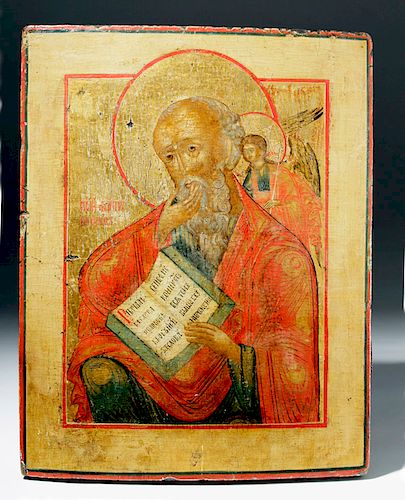Published 18th C. Russian Icon, St. John the Evangelist
Lot 57a
About Seller
Artemis Gallery
686 S Taylor Ave, Ste 106
Louisville, CO 80027
United States
Selling antiquities, ancient and ethnographic art online since 1993, Artemis Gallery specializes in Classical Antiquities (Egyptian, Greek, Roman, Near Eastern), Asian, Pre-Columbian, African / Tribal / Oceanographic art. Our extensive inventory includes pottery, stone, metal, wood, glass and textil...Read more
Categories
Estimate:
$2,500 - $3,750
Absentee vs Live bid
Two ways to bid:
- Leave a max absentee bid and the platform will bid on your behalf up to your maximum bid during the live auction.
- Bid live during the auction and your bids will be submitted real-time to the auctioneer.
Bid Increments
| Price | Bid Increment |
|---|---|
| $0 | $25 |
| $300 | $50 |
| $1,000 | $100 |
| $2,000 | $250 |
| $5,000 | $500 |
| $10,000 | $1,000 |
| $20,000 | $2,500 |
| $50,000 | $5,000 |
| $100,000 | $10,000 |
| $200,000 | $20,000 |
About Auction
By Artemis Gallery
May 10, 2018
Set Reminder
2018-05-10 10:00:00
2018-05-10 10:00:00
America/New_York
Bidsquare
Bidsquare : Fine Ethnographic / Asian / Ancient Art
https://www.bidsquare.com/auctions/artemis-gallery/fine-ethnographic-asian-ancient-art-3213
Featuring antiquities from around the world including Pre-Columbian, Tribal, Classical, Asian, so much more! Artemis Gallery info@artemisgallery.com
Featuring antiquities from around the world including Pre-Columbian, Tribal, Classical, Asian, so much more! Artemis Gallery info@artemisgallery.com
- Lot Description
Russia, ca. 18th century CE. A half-length depiction of Saint John the Evangelist, beautifully painted in egg tempera and gold leaf on wood, with a divine angel looking over his shoulder. Saint John looks pensively at the pages of his Gospel, donning blue-green and red robes. Here we see Saint John presented as an elderly man; other icons present him as a beardless young disciple. Similar to the Baptist –as a bearded old man- he merits Jesus’ sobriquet for him – the “Son of Thunder.” Size: 12.75" W x 16" H (32.4 cm x 40.6 cm)
Images of the evangelists derived from miniatures of illuminated Gospel books and Gospel lectionaries showing them at work in their scriptoria. These portrayals were oftentimes painted on the outside of the royal doors. John’s symbol is the eagle, chosen for the “sublime manner in which he described the godliness of the Word” according to Christian iconography expert Alfredo Tradigo, who writes, “of all the evangelists, he flew the highest.” (Tradigo, "Icons and Saints of the Eastern Orthodox Church" Getty Museum, 2006, p. 262)
Also known as John the Theologian for his ability to channel divine wisdom, Saint John wrote the fourth Gospel (the Book of Revelation), while living in a cave on the isle of Patmos, exiled by Emperor Trajan. There he dictated a dramatic vision of the Apocalypse to the deacon Prochorus, his disciple and steadfast companion. John also wrote the “Gospel of Love” or the “flower of the Gospel” as Origen calls it – in addition to three of the Catholic Epistles. In the words of Patriarch Athenagoras, “John is the source of our loftiest spirituality. Like him, those who are silent know the mysterious confusion that can assail the heart; invoking the presence of John, their hearts catch fire.” (Tradigo, 262)
Exhibited in "Windows Into Heaven: Russian Icons from the Lilly and Francis Robicsek Collection of Religious Art" at the Mint Museum of Art, Charlotte, North Carolina (December 20, 2003 through February 22, 2004) and the North Carolina Museum of History (October 4, 2013 through March 5, 2014) which presented highlights of one of the world's great artistic traditions through an extraordinary group of sixty-five 18th and 19th century Russian icons on loan from the private collection of Lilly and Francis Robicsek. Published in the catalogue accompanying the North Carolina Museum of History exhibition by curator Jeanne Marie Warzeski (p. 6).
Icons (icon means "image" in Greek) are sacred objects within the Eastern Orthodox Christian tradition. Found in homes as well as churches, these painted images depict holy persons and saints as well as illustrate scenes from the Scriptures. Icons are not worshiped, but are instead venerated for their ability to focus the power of an individual's prayer to God. As such they are truly "windows into heaven."
The “Windows Into Heaven” exhibition profiled a magnificent chapter of Russian artistry, the embrace of the Russian Orthodox faith of religious icons during the Romanov centuries. The Russian religious faith was an offshoot of Byzantine Christianity, which in 1054 parted ways from Roman Catholicism. Icons were and continue to be religious images created for veneration. As a focus for prayers and meditation for believers, icons serve as “windows into heaven.”
Provenance: Ex-Francis & Lilly Robicsek Collection, Charlotte, NC, part of the Museum Exhibition, Windows into Heaven - Russian Icons from the Lilly and Francis Robicsek Collection of Religious Art, North Carolina Museum of History, Raleigh, NC. Published in the catalogue accompanying the North Carolina Museum of History exhibition (p. 6).
All items legal to buy/sell under U.S. Statute covering cultural patrimony Code 2600, CHAPTER 14, and are guaranteed to be as described or your money back.
A Certificate of Authenticity will accompany all winning bids.
We ship worldwide and handle all shipping in-house for your convenience.
#119437Areas of craquelure. Surface wear with losses to pigment and gold leaf. A few losses to wood as shown. Back slats remain on verso. Wire for suspension as well as Certificate of Authenticity from Via Dolorosa, Jerusalem dating icon to 18th century on verso.Condition
- Shipping Info
-
All shipping is handled in-house for your convenience. Your invoice from Artemis Gallery will include shipping calculation instructions. If in doubt, please inquire BEFORE bidding for estimated shipping costs for individual items.
-
- Buyer's Premium



 EUR
EUR CAD
CAD AUD
AUD GBP
GBP MXN
MXN HKD
HKD CNY
CNY MYR
MYR SEK
SEK SGD
SGD CHF
CHF THB
THB
















